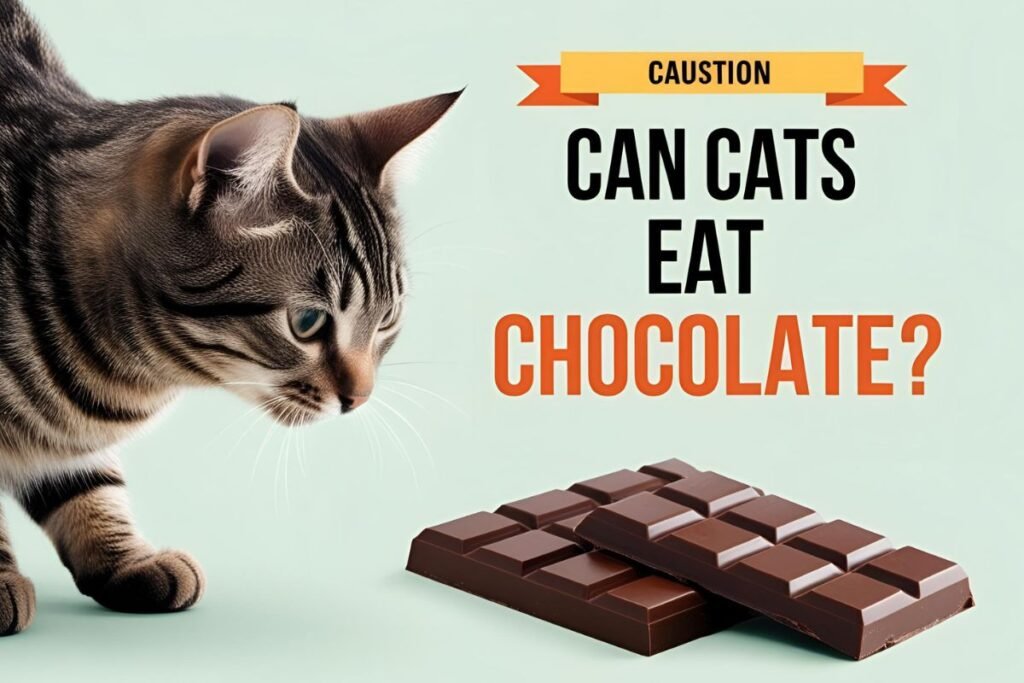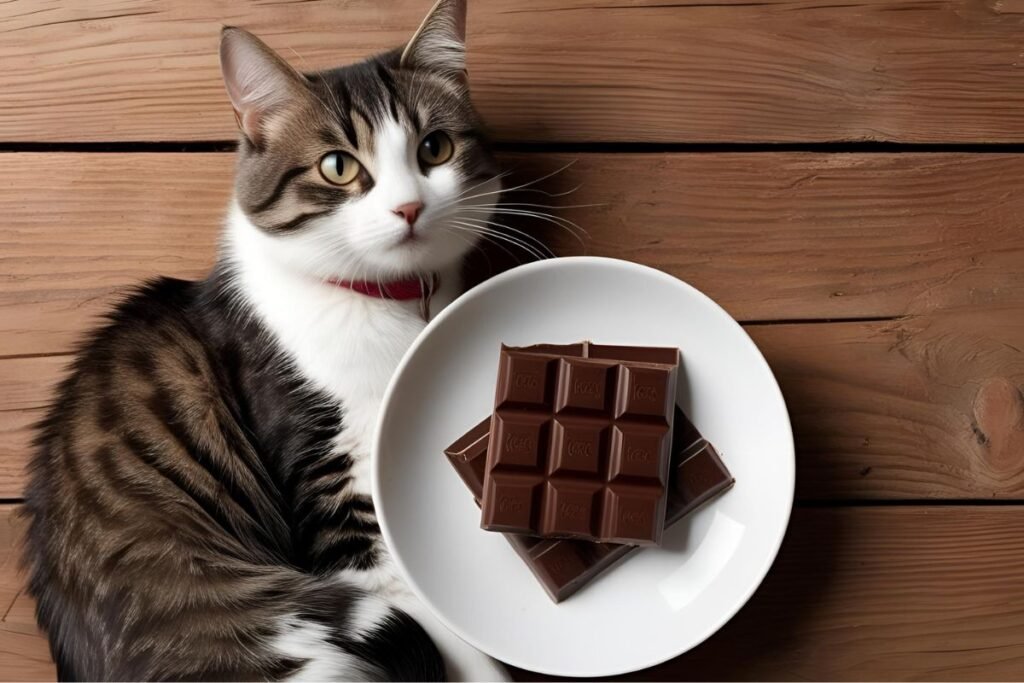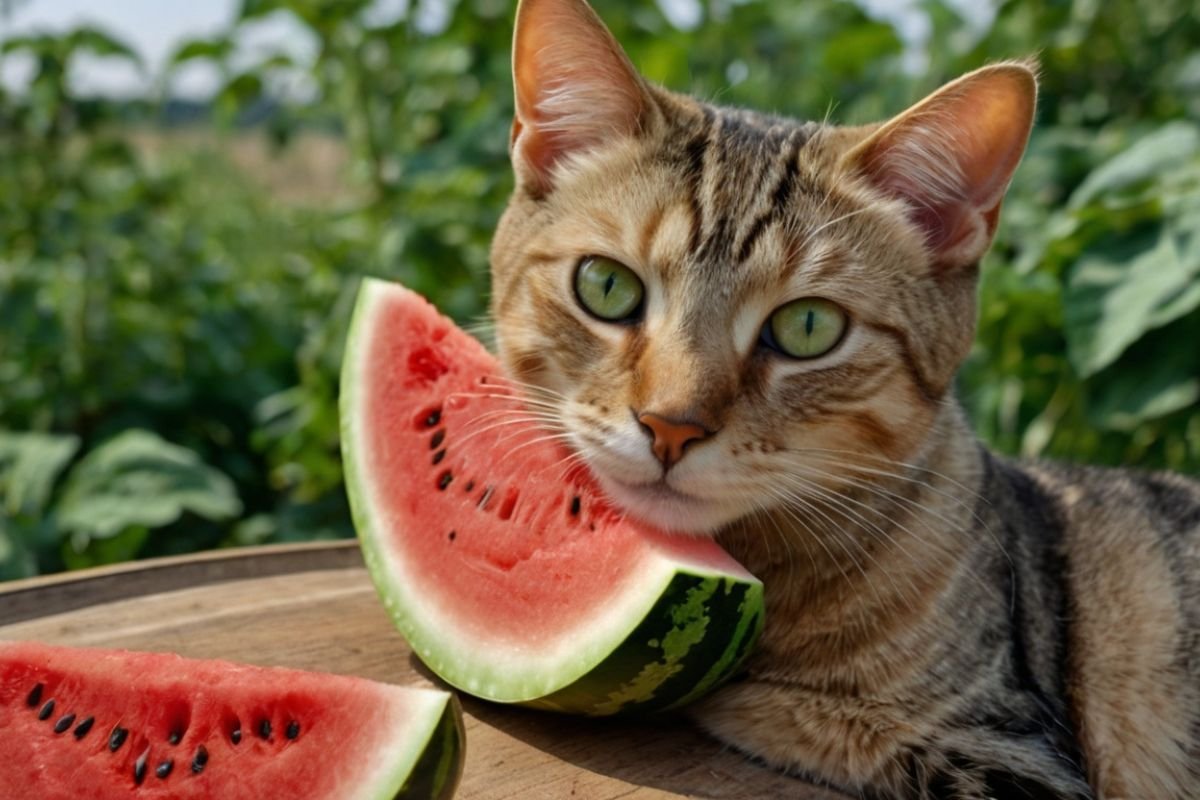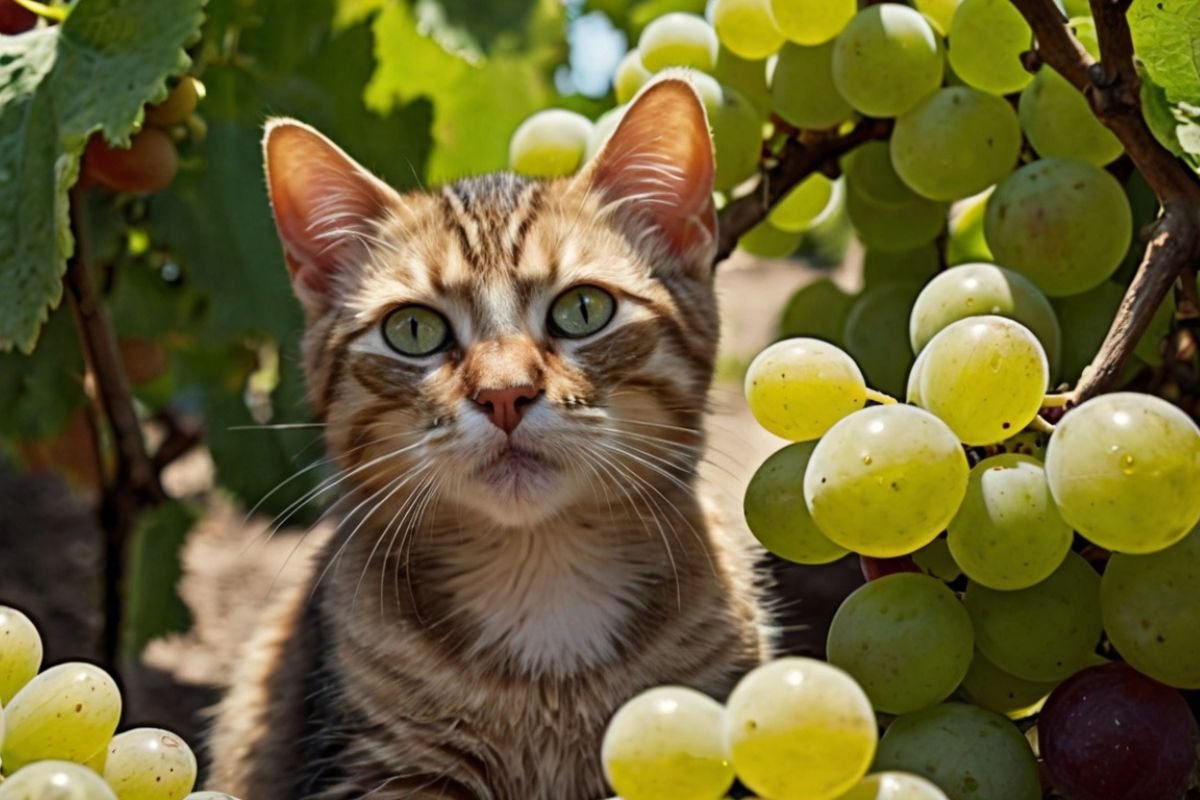I love chocolate. The rich taste, the way it melts, how it makes bad days better. My orange tabby Rio often sits near me when I enjoy a treat. His big eyes watch every bite I take. His two-year-old curiosity makes me wonder – can cats eat chocolate too? Should I share?

Table of Contents
Quick Answer
No, cats cannot eat chocolate. Chocolate is toxic to cats. It contains things that can harm or even kill them. Never feed chocolate to your cat, no matter how much they seem to want it.
My Experience with Rio
Rio (my cat) shows interest in many human foods. One day, he tried to lick a chocolate ice cream bowl I left on the table. I quickly moved it away. This scared me enough to research cat safety and chocolate. What I learned made me very careful about keeping all chocolate away from him.
Also read, Can Cats Eat Eggs?
Why Chocolate is Dangerous for Cats
Chocolate has things in it that can poison cats. Let’s look at why it’s so bad for them.
The Toxic Parts of Chocolate
Two main things in chocolate hurt cats:
- Theobromine
- Caffeine
Both are in a group called methylxanthines. These affect the body in ways that cats can’t handle well.
Cats break down these things much slower than humans do. What we can eat safely stays in a cat’s system much longer. This means the toxic stuff builds up in their body.
The darker and more bitter the chocolate, the more dangerous it is. Here’s a list from most toxic to least toxic:
- Baking chocolate
- Dark chocolate
- Milk chocolate
- White chocolate
Even a small bit of dark chocolate can harm a cat. Their small size makes them more at risk.
What These Toxins Do to Cats
When a cat eats chocolate, bad things can happen to many parts of their body:
- Heart: Racing heart rate, abnormal rhythm
- Nerves: Tremors, seizures
- Stomach: Vomiting, diarrhea
- Muscles: Weakness, stiffness
- Overall: Fever, rapid breathing, coma
The more chocolate they eat, the worse these signs get. In the worst cases, cats can die from chocolate poisoning.
Rio is a medium-sized cat at about 10 pounds. Even a small chocolate chip cookie could make him sick. A larger amount could put his life at risk.
Signs Your Cat Ate Chocolate
If your cat gets into chocolate, you need to know the signs to watch for.
Early Signs (First Few Hours)
- Vomiting
- Diarrhea
- Drinking more water
- Peeing more
- Restlessness
- Fast breathing
- Increased heart rate
Later Signs (4-24 Hours)
- Muscle stiffness
- High temperature
- Tremors or shaking
- Fast breathing
- Seizures
- Collapse
- Coma
Once I knew these signs, I became super careful with chocolate in my home. I never leave it where Rio might reach it.
What to Do if Your Cat Eats Chocolate
If you know or think your cat ate chocolate, act fast.
Emergency Steps
- Call your vet right away
- If your vet is closed, call an animal poison control line
- Try to figure out what type and how much chocolate was eaten
- Save any wrappers to show the vet
- Don’t wait for symptoms – early treatment works best
When you call the vet, they may ask:
- How much does your cat weigh?
- What kind of chocolate was it?
- How much did they eat?
- When did they eat it?
- Is your cat showing any symptoms?
Having this info ready helps the vet decide what to do next.
Possible Treatments
The vet might:
- Make your cat vomit (if very recent eating)
- Give activated charcoal to absorb toxins
- Give IV fluids
- Give medicine for seizures or heart problems
- Keep your cat for monitoring
The sooner you get help, the better the chances of recovery.
I keep my vet’s number and the ASPCA Animal Poison Control number (888-426-4435) on my fridge. I hope I never need them, but I’m ready just in case.
Why Cats Might Want Chocolate
You might wonder why cats would even want chocolate if it’s so bad for them.
The Fat and Protein Appeal
Cats are drawn to foods with fat and certain proteins. Chocolate, especially milk chocolate, has fats that might smell good to cats. They don’t want it for the sweet taste.
Cats Can’t Taste Sweet
Here’s something wild – cats can’t taste sweet things! They lack the taste buds for it. So when Rio seems interested in my chocolate, he’s not craving the sweetness. He’s curious about the fat content or simply interested in what I’m eating.
Curiosity Factor
Cats are curious by nature. Rio often wants to check out anything I eat, not because he wants it but because he’s nosy! This natural cat trait can lead them to sample dangerous foods.
Common Chocolate Items to Keep Away From Cats
Many foods have chocolate in them. Here’s what to keep far from your cat.
Obvious Chocolate Items
- Chocolate bars and chips
- Chocolate cookies and cakes
- Chocolate ice cream
- Hot chocolate and chocolate milk
- Chocolate candy (truffles, bonbons)
- Chocolate sauce or syrup
Hidden Chocolate Sources
- Some cereals
- Protein bars or meal replacement bars
- Some flavored coffees
- Chocolate-flavored medicine
- Some alcohol drinks (chocolate liqueurs)
- Chocolate-covered nuts or fruits
I check labels carefully. Even items with small amounts of chocolate get stored in cat-proof places.
Safe Chocolate Alternatives for Cats
If you want to give your cat a special treat, skip anything chocolate. Try these safe options instead.
Commercial Cat Treats
Many tasty treats are made just for cats. Look for ones with:
- Few ingredients
- Named meat as first ingredient
- No artificial colors or flavors
Rio loves freeze-dried chicken treats. They’re pure protein and make him purr like crazy.
Homemade Safe Treats
You can make simple cat treats at home:
- Small bits of cooked chicken or turkey
- Tiny pieces of cooked fish
- A little plain yogurt (if your cat handles dairy well)
- A bit of cooked egg
Remember that treats should be only a small part of your cat’s diet – less than 10% of daily calories.
How to Keep Chocolate Away From Cats
Prevention is vital when it comes to chocolate and cats.
Storage Solutions
- Keep chocolate in closed cabinets or drawers
- Store baking chocolate on high shelves
- Don’t leave chocolate gifts under Christmas trees
- Keep purses with chocolate closed and stored away
- Put empty chocolate wrappers in covered trash cans
Training Tips
Some basic training can help:
- Teach your cat that human food isn’t for them
- Use a firm “no” if they show interest in your food
- Never feed human food from your plate or table
- Give proper cat treats to reward good behavior
Rio knows the sound of “no” when he gets too interested in my food. I always follow up by giving him a proper cat treat instead.
The Science Behind Chocolate Toxicity
Let’s explore why chocolate affects cats so badly on a deeper level.
How Cats Process Toxins Differently
Cats lack certain liver enzymes that humans have. These enzymes help break down many toxins. Without them, harmful things stay in a cat’s system much longer.
This liver difference affects how cats handle many human foods and medicines. It’s also why chocolate is worse for cats than dogs (though still bad for both).
Theobromine in Detail
Theobromine is the main chocolate danger. It affects cats in these ways:
- Makes the heart beat faster and irregular
- Opens up blood vessels
- Makes kidneys work harder
- Stimulates the central nervous system
- Relaxes smooth muscles (like in lungs)
For humans, these effects are mild. For cats, they’re strong and dangerous.
A small 10-pound cat like Rio might get sick from just 20 mg of theobromine. For comparison, one ounce of milk chocolate has about 60 mg of theobromine.
Myths About Cats and Chocolate
Let’s clear up some wrong ideas about cats and chocolate.
Myth: A Little Bit Won’t Hurt
Some people think tiny amounts of chocolate are OK for cats. This isn’t true. While a microscopic amount might not cause visible symptoms, any chocolate can harm a cat. Why take the risk?
Myth: My Cat Ate Chocolate Once and Was Fine
Just because a cat seems OK after eating chocolate once doesn’t mean it’s safe. The cat might have eaten a very small amount or a less toxic type. Or the cat might have had internal damage you couldn’t see.
Myth: White Chocolate is Safe
While white chocolate has less theobromine than dark chocolate, it still has some. It also has fat and sugar that aren’t good for cats. No type of chocolate is safe for cats.
Myth: Cats Know What’s Bad for Them
This is simply not true. Cats don’t have built-in knowledge of what foods are toxic. They make choices based on smell, texture, and what they see their humans eating.
Other Foods Toxic to Cats
While we’re talking about chocolate, it’s good to know other foods to keep away from cats.
Common Toxic Foods for Cats
- Onions and garlic
- Grapes and raisins
- Alcohol
- Xylitol (in sugar-free foods)
- Raw dough with yeast
- Caffeine (coffee, tea, energy drinks)
- Alcohol
I keep all these away from Rio just like I do with chocolate.
Recovery After Chocolate Ingestion
If your cat does eat chocolate and gets treatment, what happens next?
The Recovery Process
Recovery depends on how much they ate and how fast they got help. With prompt treatment, many cats recover well.
After treatment, your vet might:
- Send your cat home with special food
- Recommend rest and quiet time
- Ask you to watch for ongoing symptoms
- Schedule a follow-up visit
- Suggest blood tests to check organ function
Long-term Effects
Most cats who get quick treatment have no lasting effects. Cats who eat large amounts or don’t get fast help might have lasting heart or kidney damage.
Why Cats Are More Sensitive Than Other Pets
Cats seem to be extra sensitive to many toxins. Here’s why.
Unique Cat Biology
Cats are obligate carnivores. This means they must eat meat. Their bodies are designed to process meat, not plants or sweets.
Over time, cats lost the ability to break down many plant compounds. They also have a smaller body size than many dogs, making toxins more concentrated in their system.
Rio weighs just 10 pounds. The same amount of chocolate that might make a 60-pound dog sick could kill a cat his size.
Special Risk Times: Holidays
Certain times of year bring more chocolate into homes.
Holiday Dangers
- Valentine’s Day: Boxed chocolates left out
- Easter: Chocolate eggs and bunnies
- Halloween: Candy collected by kids
- Christmas: Chocolate gifts, advent calendars
- Baking seasons: More baking chocolate in the kitchen
During these times, I’m extra careful about where I put chocolate items. I remind visitors not to leave chocolate where Rio can get it.
Cat-Proofing Your Home From Chocolate
Beyond just putting chocolate away, here are ways to cat-proof your home.
General Cat-Proofing Tips
- Use child-proof latches on cabinets with food
- Keep kitchen counters clear when you’re not there
- Take out trash with food wrappers promptly
- Tell guests about not giving treats to your cat
- Be extra careful when you have parties or gatherings
For Multi-Pet Homes
If you have both cats and dogs, be extra careful. Dogs are often fed treats that cats shouldn’t have. Also, some cats will eat dog food, which might have ingredients cats should avoid.
I have a friend whose cat got sick from eating the dog’s treat that had a chocolate coating. The treat was safe for the dog but dangerous for the cat.
Teaching Children About Cat Safety
If you have kids, teach them about keeping cats safe from chocolate.
Kid-Friendly Rules
- Never share chocolate with pets
- Keep candy in closed containers
- Tell a grown-up if you drop chocolate
- Don’t leave wrappers where cats can get them
- Know which treats are made for cats
Simple rules help keep everyone safe. Kids often want to share their treats with pets they love, so explaining why this is dangerous is important.
What Vets Want You to Know
I asked Rio’s vet what she thinks cat owners should know about chocolate. Here’s what she said.
Vet Advice on Chocolate and Cats
- There is no safe amount of chocolate for cats
- Don’t wait for symptoms to get help
- Keep records of what your cat might have eaten
- Prevention is much better than treatment
- Know your vet’s emergency contact info
The vet also said many cat owners don’t realize how little chocolate it takes to cause problems. A single chocolate chip cookie could be enough to make a small cat sick.
Real Stories: Cats and Chocolate
Here are stories from other cat owners about chocolate incidents.
Warning Tales
My friend Sarah’s cat Milo got into her baking chocolate. She found him with the wrapper and rushed him to the emergency vet. They made him vomit and gave him charcoal. He needed to stay overnight but recovered fully. Sarah now keeps all chocolate in sealed containers inside closed cabinets.
Another cat owner told me her kitten licked a chocolate ice cream bowl. The kitten seemed fine, but later that night had diarrhea and seemed restless. A vet visit confirmed mild chocolate toxicity. The kitten was OK after treatment, but it was a scary lesson.
Frequently Asked Questions About Cats and Chocolate

Here are answers to common questions about cats and chocolate dangers.
FAQ
Q: How quickly will a cat show signs of chocolate poisoning?
A: Signs can start within 2-4 hours after eating chocolate but may take up to 24 hours for all symptoms to show.
Q: Does chocolate ice cream have enough chocolate to hurt my cat?
A: Yes, chocolate ice cream contains enough chocolate to be toxic, plus the dairy can cause stomach upset.
Q: My cat only licked a chocolate wrapper – should I worry?
A: There’s likely a small amount of chocolate on wrappers. Watch your cat closely for symptoms and call your vet if you’re concerned.
Q: Can cats die from eating chocolate?
A: Yes, in severe cases, chocolate toxicity can cause death if not treated.
Q: If my cat steals chocolate once and seems fine, is it OK to give tiny bits as treats?
A: Absolutely not. The effects of chocolate toxicity can build up over time, and no amount is safe.
Q: How long does chocolate toxicity last in cats?
A: The effects can last 24-72 hours, depending on the amount eaten and the cat’s size.
Safe Treat Alternatives Your Cat Will Love
Since we can’t give cats chocolate, here are some treats they can enjoy safely.
Store-Bought Options
Many companies make treats cats love:
- Freeze-dried meat treats
- Dental health treats
- Catnip treats
- Treats with added vitamins
Rio goes crazy for Temptations treats. I use them for training and special occasions.
DIY Cat Treats
You can make simple treats at home:
Easy Chicken Treats
- Cook plain chicken
- Cut into tiny pieces
- Bake at 350°F until crispy
- Store in airtight container
These are Rio’s absolute favorite. He comes running when he hears me shake the treat container.
The Bottom Line on Cats and Chocolate
Let me sum up what we’ve learned about cats and chocolate.
Key Takeaways
- Chocolate is toxic to cats because of theobromine and caffeine
- Dark chocolate and baking chocolate are most dangerous
- No amount of chocolate is safe for cats
- Signs of chocolate poisoning include vomiting, increased heart rate, and seizures
- Call your vet right away if your cat eats chocolate
- Prevention is the best approach
- Many safe treats can make your cat happy without the risks
I’ve learned to enjoy my chocolate treats when Rio is not around or to put him in another room first. His safety matters more than his curiosity.
Final Thoughts
Knowing what foods are safe for our cats helps us be better pet parents. While it might seem kind to share treats like chocolate, true kindness is keeping harmful things away from our furry friends.
Rio doesn’t know chocolate would hurt him. It’s my job to protect him by keeping dangerous foods out of reach. With so many safe treats made just for cats, there’s no reason to risk the dangers of chocolate.
Does your cat have a favorite safe treat? Maybe it’s time to find some new ones to try! Just remember – keep the chocolate for yourself and find cat-approved goodies for your feline friend.
As I finish writing this, Rio is sleeping peacefully nearby. I’m eating a chocolate cookie, but I’ve put it on a high shelf when I take breaks to pet him. This small effort keeps him safe and lets me enjoy my treats with peace of mind.
The question “Can cats eat chocolate?” has a clear answer: no, never. But the good news is that there are plenty of other ways to show our cats love and give them treats they can enjoy safely.

Shahriar Robin is the creator of WhatPetsCanEat.com, a passionate pet lover and dedicated cat dad to Rio, a curious two-year-old orange feline who inspired this website. With a love for animals and a knack for research, Shahriar shares trusted, easy-to-understand information to help fellow pet owners make safe, healthy food choices for their furry friends.


